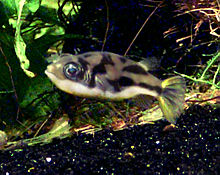- Dwarf pufferfish
-
Carinotetraodon 
Conservation status Scientific classification Kingdom: Animalia Phylum: Chordata Subphylum: Vertebrata Class: Osteichthyes Order: Tetraodontiformes Family: Tetraodontidae Genus: Carinotetraodon Species: C. travancoricus Binomial name Carinotetraodon travancoricus
(S. L. Hora & K. K. Nair, 1941)The dwarf pufferfish, also known as the Malabar pufferfish, pea pufferfish or pygmy pufferfish, Carinotetraodon travancoricus is a small, freshwater pufferfish endemic to the River Pamba in Kerala, Southwest India. Maximum size is 22 mm (less than one inch), making it one of the smallest pufferfish in the world.[2] Although closely related to marine pufferfish, they are not found in brackish or salt water, and reports to the contrary are based on misidentification.[3]
Contents
Appearance
Both sexes are primarily yellow with dark green to black iridescent patches on the flanks and dorsal surface, but as with other members of the genus, sexual dimorphism is apparent in mature fish, with males being more brightly coloured than females.[2] Males can also have a dark stripe down the center of their pale belly and iridescent "eye wrinkle" patterns that females lack.
Reproduction
Often dwarf pufferfish are plant-spawners, laying eggs in plants, including java moss in aquariums. Eggs have been seen to hatch after five days at 27 °C (81 °F), with fry initially feeding on infusoria, brine shrimp when they're a week old, and finally regular-sized food when possible.[4] Dwarf pufferfish have also been known to scatter their eggs on the substrate hidden within vegetation. The eggs are fertilized externally. They do not guard their eggs or fry. After the eggs hatch, take out the fry; it is not recommended that you keep the adults and the fry together. A small tank of about ten gallons is acceptable. Once the fry have matured some, you can keep them or sell them, but are not very popular.[5][6]
Conservation
Dwarf pufferfish are not used as food but are traded as aquarium fish.[2] It has been classified as "vulnerable" on the IUCN Red List due to changes in habitat and overharvesting for the aquarium trade. [1]
Diet
The diet of dwarf pufferfish in the wild has not been reported, but other members of the genus feed on zooplankton and various benthic crustaceans and molluscs.[7] Food items of specimens maintained in aquaria appears to be similar.[2] In fact, the dwarf puffer is one of the few aquarium fish to regularly eat small live snails and can be useful in controlling snail populations (larger snails do not interest them).
Dwarf pufferfish in aquarium
Dwarf pufferfish have become quite popular as aquarium fish thanks to their attractive colours, small size, and relative ease of maintenance.[2] Like all pufferfish, they can be aggressive, especially towards creatures smaller than themselves, and it is commonly recommended to keep them in a dedicated "species only" tank. A female to male ratio of 2 to 1 is sometimes recommended to reduce aggression in captive fish.
Despite what the fish stores may indicate, flake fish food is not a recommended diet for Dwarf Puffers, and many fish will refuse to take this food. If you are persistent, you may be able to feed them dried worms, and they will eat live (and frozen) bloodworms with relish. Puffers are notoriously messy eaters, it is therefore important not to overfeed, and to employ a good filtration system.
They may also eat small shrimp, or can be kept with them, some individuals may or may not eat shrimp kept in the same tank. Red ramshorn snails, Live & froen bloodworms, brine shrimp, triops.
References
- ^ a b "Carinotetraodon travancoricus". IUCN Red List of Threatened Species. Version 2011.1. International Union for Conservation of Nature. 2010. http://www.iucnredlist.org/apps/redlist/details/166591. Retrieved 28 June 2011.
- ^ a b c d e Klaus Ebert (2001). The Puffers of Fresh and Brackish Water. Aqualog. pp. 19, 46–49. ISBN 393170260X.
- ^ Schäfer F. Brackish Water Fishes, p 34. Aqualog 2005, ISBN 3-936027-82-X
- ^ Ralph, Chris (2003). Practical Fishkeeping: Pufferfish, p. 61. ISBN 1-86054-233-6
- ^ Froese, R. and D. Pauly. Editors.. "Reproduction Summary: Carinotetraodon travancoricus". FishBase. http://filaman.ifm-geomar.de/Reproduction/FishReproSummary.cfm?ID=25293&GenusName=Carinotetraodon&SpeciesName=travancoricus&fc=448&StockCode=20036. Retrieved 2007-03-07.
- ^ Wenzel, R. (2004). Carinotetraodon travancoricus. Die Aquarien- und Terrarienzeitschrift 1/2004:36-37
- ^ Froese, R. and D. Pauly. Editors.. "Food Items Reported for Carinotetraodon lorteti". FishBase. http://filaman.ifm-geomar.de/TrophicEco/FoodItemsList.cfm?vstockcode=19922&genus=Carinotetraodon&species=lorteti&CFID=2205913&CFTOKEN=31807211. Retrieved 2007-03-07.
External links
- Froese, Rainer, and Daniel Pauly, eds. (2007). "Carinotetraodon travancoricus" in FishBase. March 2007 version.
- Care information for Dwarf Puffers kept in the home Aquarium
- Dwarfpuffers.com is an online community with forums, care sheets, FAQs, and other information that couldn't be fit here
Categories:- IUCN Red List vulnerable species
- Carinotetraodon
- Fishkeeping
- Animals described in 1941
Wikimedia Foundation. 2010.

